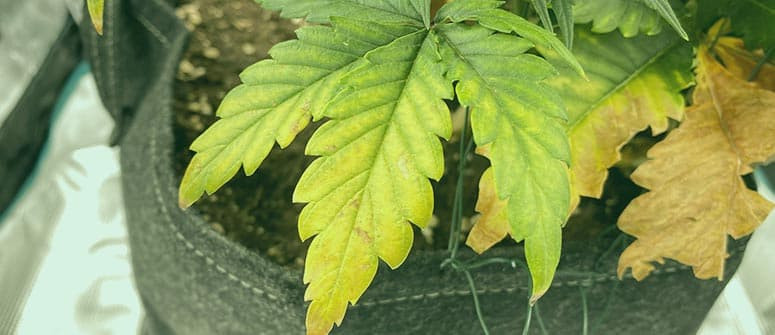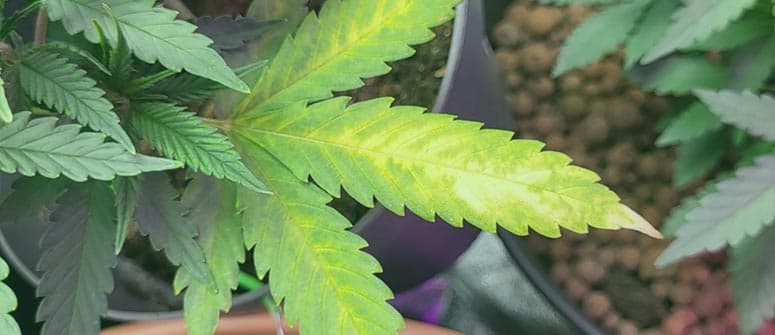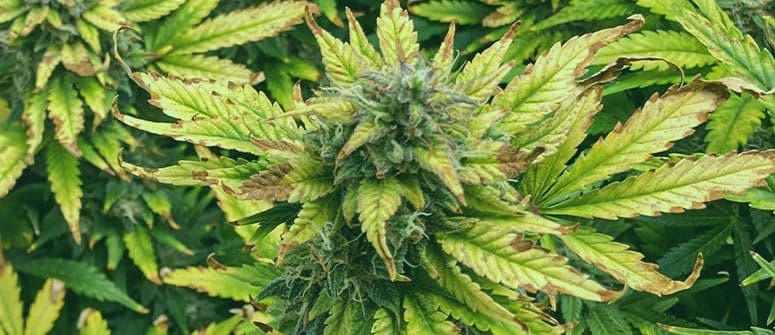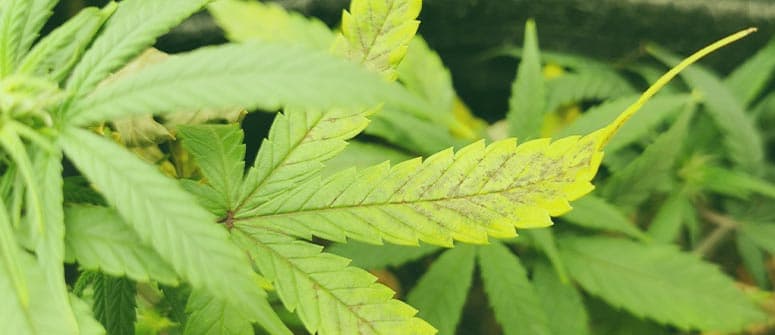Yellow cannabis leaves: How to diagnose

Yellow cannabis leaves can be concerning, especially if you're new to growing. However, in many cases, it's totally natural and nothing to worry about. Even when it is indicative of a problem, it can often be solved if you catch it early enough. Here we provide a rundown of the most common reasons for yellow marijuana leaves, and their solutions.
Contents:
Growing cannabis can sometimes go off without a hitch, and other times it can be inexplicably plagued by problems.
There’s one symptom that is common to the majority of cannabis plant problems: yellow leaves. Below, we review an extensive list of reasons why your plant’s leaves might have turned yellow, and what you can do about it.
Top tip: the sooner you act, the less you need to worry!
Diagnosing yellow cannabis leaves

If you notice your cannabis plant’s leaves beginning to yellow, the first port of call is figuring out exactly what’s going on. Seeing yellow leaves can be immediately concerning, but it needn’t always be a cause for alarm—your plant could be totally healthy. Nevertheless, to ensure that nothing is amiss, it’s vital to rule out any possible issues.
Yellow leaves, aka chlorosis, occur when cannabis plants become unable to produce chlorophyll properly. Indeed, it’s chlorophyll that gives plants their green colouration. Yellow leaves are one of the telltale signs that something is not right with a plant, and, most of the time, are easy to set right.
The two types of cannabis leaves
Cannabis plants feature two types of leaves: fan leaves and sugar leaves.
Fan leaves are those large, multi-fingered leaves that grow abundantly on the plant during the vegetative stage, and account for the lion’s share of photosynthetic power. Sugar leaves, on the other hand, are those tiny, single-fingered leaves that grow at the base of buds. As hinted at by their name, sugar leaves tend to feature a decent covering of trichomes, which makes them sticky and crystalline, like sugar.
For the most part, issues with yellowing tend to affect fan leaves first, but this is not always the case. Where issues are specific to sugar leaves, this will be indicated.
When not to worry about yellow cannabis leaves
Due to senescence (ageing), cannabis leaves will naturally yellow and wither toward the end of the plant’s life, and it’s nothing to worry about. As the plant gets older, especially as it matures into the flowering stage, leaves lower down along the stem will inevitably yellow and drop off.
The reason for this is that the plant is directing its energy toward producing flowers, and thus supporting the lower leaves that receive the least light is not an efficient use of energy.
In this instance, you needn’t worry about yellow leaves at all.
Most common causes of yellow marijuana leaves

As you’re about to find out, there are many reasons a cannabis plant’s leaves might turn yellow. In most cases, there are specific symptoms you can use to identify the underlying cause, which we will outline here. Then, we’ll tell you how to fix the problem.
Overwatering
Overwatering is incredibly common, especially among first-time cannabis growers. You may think a cannabis plant wants as much water as it can get, but this is far from the truth. Too much water can essentially drown a plant’s roots, eventually killing it. And indeed, one of the telltale signs of overwatering is yellowing of the leaves.
There are two main problems with overwatering. First, soaked soil stops oxygen from reaching the roots, which is ultimately fatal. Second, wet, stagnant environments are very hospitable to pathogens, greatly increasing the likelihood of root-related infections.
Symptoms of overwatering
- Leaves turning yellow-brown, from the bottom of the plant moving upward
- As leaves wilt, they become wet and mushy
- New growth becomes brown
- Rotting roots may give off a musty smell
How to fix overwatering
Fixing overwatering is fairly simple, but it can be a hassle. Moreover, quick action is necessary. Once root rot has taken hold, it will continue to spread if the problem isn’t treated.
To fix a progressed case of overwatering, you must remove the entire plant from the soil, get rid of the rotting roots, and let the healthy roots dry out a little. Then, you must re-pot in new, damp soil.
Underwatering
Much as overwatering is an issue, so is underwatering—but one that is very easy to fix!
Underwatering can occur for a few reasons. Maybe your schedule is too conservative; maybe your plants have begun to flower but you haven’t increased the amount of water; maybe the light/environment is too hot, or perhaps your substrate drains too fast. Any of these could lead to dehydration and are, usually, easily resolved.
Symptoms of underwatering
- Yellow leaves throughout the plant
- Leaves shrivel but take on a dry, crispy quality
- Whole plant could begin to sag
- Growth will slow and eventually stop
How to fix underwatering
In most cases, fixing underwatering is easy: simply add more water! There’s no fancy solution; you literally just need to give your plant a drink.
However, it’s also worth looking at what went wrong to avoid it in the future. Have you simply been underwatering, or is your environment too hot or inhospitable? Too much heat will stunt growth, so it’s worth watching out for this. Try to keep daytime conditions below 30°C if possible.
pH issues
In soil, cannabis likes a pH of 6.0 to 7.0. In a hydro or coco grow, 5.5 to 6.5 is ideal. Step outside of these ranges, and the roots will no longer be able to optimally absorb nutrients from the substrate, leading to discolouration and yellow leaves.
Symptoms of pH issues
- Yellowing leaves
- Brown spots on leaves
- Drying leaves
- Slow or stalled growth
How to fix pH issues
Depending on the issue, you either need to increase or decrease the pH of your growing medium. First, invest in a pH meter so you know what the pH of your soil and water/nutrient solution are. When you’re aware of what the issue is, you can adjust accordingly.
If the pH is too low (unlikely), you can adjust it with a higher-pH water until the runoff reads at the correct level. More likely is that the pH is too high, as most water is neutral or slightly alkaline (pH 7+). In this case, you need to lower the pH, and maybe even flush the soil if it’s incredibly high.
In either case, adjusting pH is fairly simple using dedicated pH “up” and “down” products, and your plant should recover promptly.
Nutrient lockout and nutrient deficiencies
Nutrient lockout tends to occur when you have overfed your plant. A buildup of feed in the soil means the roots are no longer able to absorb nutrients, leading to potentially worrying issues, such as nutrient deficiencies. Nutrient deficiencies can also occur as a result of poor-quality soil or underfeeding, but this is less common.
The symptoms of nutrient lockout and nutrient deficiencies can appear identical, so we'll include them together. Although, it's important to note that the solutions can be different depending on the cause of the deficiency.
Symptoms of nutrient lockout and nutrient deficiencies
- Leaves yellowing at outer edges and veins (magnesium)
- Leaves yellowing at base and moving toward the tips (sulphur)
- Yellowing of older, lower leaves, moving upward (nitrogen)
- Discolouration starting at the tip of the leaf and moving inward (phosphorous)
- Dull colouration and “burning” (potassium)
- Brown spots on upper fan leaves (calcium)
How to fix nutrient lockout
Flush! If you’ve overfed your plants, it won’t go away without intervention. Run several litres of water through the soil until you’ve flushed out all of the nutrients. Then, you can gradually begin adding them again, but restrain yourself this time!
How to fix a nutrient deficiency
If you've got a nutrient deficiency resulting from underfeeding, there's no need to flush. You can just increase the amount of the specific nutrient(s) that's lacking, and carry on as normal. If your deficiency is the result of lockout, however, you will in fact need to flush the medium.
Light burn
Light burn is exactly what it sounds like. Essentially, if your cannabis plants are positioned too close to the lights, the leaves can become burned—either from the heat, or just from light that is too bright.
Symptoms of light burn
- Yellowing or browning of upper fan leaves, and potentially on sugar leaves and buds too
- Lower leaves shouldn’t be affected; if they are, something else is going on
How to fix light burn
Move the lights further away. It’s that simple. Note that some lights are hotter and/or more powerful than others, and refer to the recommended hanging distance associated with your specific lighting setup to avoid any potential issues.
Excessive temperatures
Temperatures above 28–30°C can be problematic for cannabis plants. Not only does it make it hard for them to stay hydrated, but also to efficiently photosynthesise.
Symptoms of excessive temperatures
- Discolouration of fan leaves
- Thin and wispy bud production
How to fix excessive temperatures
If you’re growing outdoors, there’s not a huge amount you can do, other than to move your potted marijuana plants to shade or erect some sort of covering.
But if you’re growing indoors, you have some options. The best is some form of air conditioning, which will allow you to optimise the temperature in your grow space.
Bud rot
Bud rot is many growers' worst nightmare. If it sets in, it may be that the whole plant is done for. Therefore, in the case of bud rot, prevention really is the best cure. However, if you catch bud rot early, you can avert the very worst outcomes.
Symptoms of bud rot
- Yellowing of sugar leaves from the base outward, as the base of the bud rots first
- Brown spots on buds, with the whole flower eventually turning brown
- Wet, rotten patches
How to fix bud rot
Bud rot is a fungal infection, and an aggressive one.
If you spot a bud that’s fallen victim to rot, it’s too late. Cut it off and discard it (we don’t recommend smoking infected buds). Then, keep a very careful eye on other buds, as the spores may already have spread.
If only one plant is infected, consider separating it from the others in the hope that it saves them.
Preventing bud rot is easier than treating it, here's how:
- Don’t let the humidity get too high; fungi love humid environments. Likewise, stagnant air will contribute to this. Use a fan to keep air circulating and combat all sorts of fungal infections.
- Defoliate bushy cannabis plants. Lots of fan leaves make for a humid environment and poor air circulation. Prune bushy plants, especially lower down.
Pest infestation
A pest infestation can be obvious or subtle, and there are many different manifestations of this. Though yellow leaves aren’t always the main symptom, they can occur as a knock-on effect.
It’s not possible to provide details of individual infestations here, but there are some general indications that your crop is host to pestilence.
Symptoms of pest infestation
- Visible pests or eggs—if you see things crawling around on your plants, you may have a problem
- Cobweb-like substance on your plants
- Poor growth or discolouration of leaves
How to fix a pest infestation
First, you must identify which pest you’re dealing with. Then, depending on the type of grow, you have various options.
If growing outdoors (or even indoors), you can introduce natural predators, such as ladybirds. Otherwise, some sort of organic pesticide or deterrent might be necessary.
Note: before spraying your plants with pesticides, perhaps weigh up if it’s worth damaging the environment for the sake of your smoke, or whether you should let it go.
If you spot yellow marijuana leaves, don't panic!

If you notice yellow leaves, don’t wait—identify the problem as soon as possible. If you act in time, there’s a very good chance you can restore your plants to full health with relative ease. You may even realise there’s nothing to worry about, and that you needn’t do anything at all.
As with many issues in life, acting fast and effectively ensures the greatest chance of solving them. Leaves tend to yellow or discolour long before anything is gravely wrong, and will recover their colour (in most cases) once the problem has passed.
So if you notice yellow leaves, there’s no need to freak out. A good harvest can still be yours!
.jpg)
.jpg)

.jpg)
